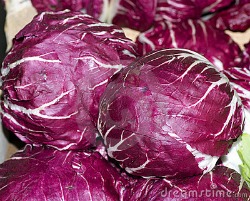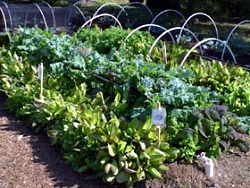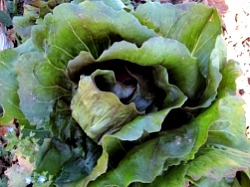
Red and white headed radicchio is great to spice up a salad or used grilled, roasted or braised.

Grow radicchio as you would lettuce giving it plenty of sun and water to grow its best.
There is lettuce — and then there's radicchio. I like to think of radicchio as lettuce with a cosmopolitan flair. This versatile green can be grown and picked as a loose-headed lettuce when young and enjoyed in salads along with many other fresh greens in summer. But where it really shines is when the loose leaves mature into a firm head. The softball-sized radicchio head is colored white and purplish-red and has a crunchy, slightly bitter flavor that's great used to spice up salads. I like it served alone dressed simply with olive oil and balsamic vinegar.
Radicchio is an old world vegetable that has found a following in the new world. This chicory thrives when grown during cool weather. It will actually bolt (form a flower stalk) if grown in the heat or stressed by lack of water. Old varieties of radicchio take sometimes up to 100 days to produce a crunchy red and white head. Newer varieties are quicker to mature. But both are worth the wait as radicchio can be cooked a variety ways in the kitchen; it’s delicious grilled, braised, roasted, and added to soups.
PlanningRadicchio needs consistent cool temperatures to produce the best heads. Old heirloom varieties have a lot of variability in their growth and sometimes are quicker to bolt. For these varieties, the quality of the heads was often dictated by planting date, variety, and the weather. A lot of the guesswork has been removed from growing radicchio with the advent of newer, more uniform hybrid varieties. Radicchio can be planted in spring for a summer harvest in cool climates or in summer for a fall harvest. In milder winter climates radicchio is often planted in fall and harvested early the next spring. The key is to have the head maturing during cool weather for the best flavor and quality.
There are two types of radicchio varieties based on their shape. The round-headed types are called chioggia. The elongated-head types are called treviso. Here are some old and new varieties to try in your garden. Some folks like the flavor of older varieties compared to newer ones, while newer varieties are more uniform. Older varieties can take 80 to 90 days to form a head, while hybrids can form heads in as little as 60 days from transplanting.
'Chioggia Red Preco No. 1' – An early and quick maturing round headed variety that is bolt resistant and well adapted to spring and early summer growing.
'Indigo Hybrid' – A very uniform round-headed variety with a rich burgundy color. Good for spring, summer, or fall production.
'Fiero Hybrid' – An elongated-shaped large head with maroon coloring. It's an early variety that's adapted to growing in all seasons.
'Palla Rosa' – A round headed variety with a distinct tangy flavor that is slow to turn bitter. Good for summer and fall planting.
'Rosa Di Treviso Precoce' – An early maturing heirloom variety that produces elongated-shaped heads with brilliant red leaves.
PreparationPrepare the soil for radicchio as you would head lettuce. Build raised beds in spring one month before the last frost date and amend the soil with compost.
Planting
You can also eat radicchio like a lettuce, harvesting the young greens for salads.
In spring, plant seeds indoors eight weeks before the last frost date. They will be transplanted into the garden four weeks later -- the same time you'll be direct seeding radicchio. Radicchio is cold tolerant and can take a light frost. Transplanting seedlings is usually better than direct seeding. However, if you want to direct seed, sow in rows in the raised beds and thin to 8 inches apart after the true leaves form. Plant transplants 8- to 10-inches apart in rows spaced 18 inches apart. Consider planting small batches of transplants every few weeks to determine the best planting times in your region. In most regions planting a summer crop for fall harvest is more reliable. In mild winter areas, you can also plant in fall for an early spring harvest.
CareRadicchio requires consistent moisture and fertilizer to grow and head up best. Long days, heat, and dry soil will force the plants to bolt before forming heads. Also, protect plants when temperatures dip below 50 degrees F when the plants are seedlings, as this also can induce bolting. While night temperatures around 60 degrees F are usually best for head formation, radicchio can tolerate hot temperatures if it has sufficient water. However, too much water can cause heart rot, so well-drained soil and raised beds are crucial to radicchio success.
Once plants are established, mulch the bed with a 2- to 3-inch thick layer of untreated grass clippings, hay, or straw. The mulch will keep the weeds from growing and help maintain the soil's moisture content. Fertilize monthly with fish emulsion to keep the crop growing strong.
Radicchio is generally pest free, as most insects pests and animals don't like the slightly bitter flavor. Plants can develop tip burn on the leaves during hot weather and rotting during cool, rainy weather. Select varieties with tip burn resistance and plant on well-drained soil to prevent rotting.
HarvestHarvest radicchio heads by cutting them just below the head with a sharp knife once they're firm, like a small cabbage. If your radicchio isn't forming heads after a few months of growing, cut the plant back to 1-inch above the ground, use the leaves in salads, and the new growth should form a head. Fall maturing radicchio will hold longer in the garden than summer maturing plants so you don't have to rush and harvest it before it bolts.
Other radicchio stories:Really Cool Salads
Spring Chicories
Growing Endive and Chicory
 Charlie Nardozzi is an award winning, nationally recognized garden writer, speaker, radio, and television personality. He has worked for more than 30 years bringing expert gardening information to home gardeners through radio, television, talks, tours, on-line, and the printed page. Charlie delights in making gardening information simple, easy, fun and accessible to everyone. He's the author of 6 books, has three radio shows in New England and a TV show. He leads Garden Tours around the world and consults with organizations and companies about gardening programs. See more about him at Gardening With Charlie.
Charlie Nardozzi is an award winning, nationally recognized garden writer, speaker, radio, and television personality. He has worked for more than 30 years bringing expert gardening information to home gardeners through radio, television, talks, tours, on-line, and the printed page. Charlie delights in making gardening information simple, easy, fun and accessible to everyone. He's the author of 6 books, has three radio shows in New England and a TV show. He leads Garden Tours around the world and consults with organizations and companies about gardening programs. See more about him at Gardening With Charlie.
 Victory Seed Company has all the seeds you want for your best garden in 2024.
Victory Seed Company has all the seeds you want for your best garden in 2024.
For 25 years, the family-owned Victory Seed Company has provided the highest quality vegetable, herb and flower seeds to families across the country. We are passionate about providing you the best seeds available that give excellent germination, robust plants, and the harvest you want. With a catalog of over a thousand varieties, we have everything, and our prices are the kinds that we'd want to pay. We have hundreds of yesterday's heirloom vegetables, as well as today's award winning hybrid selections. Get to know us by visiting our website and browsing through our online vegetable seed catalog.